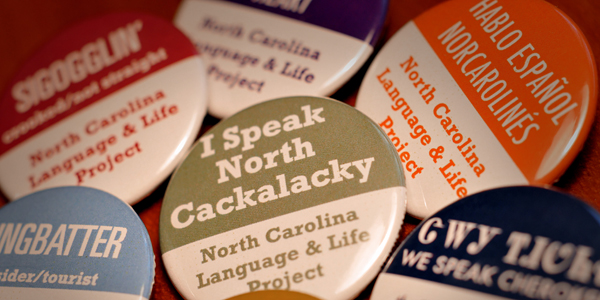Linguistics Project the Talk of the Fair

Walt Wolfram may have grown up in Philly, but he can pinpoint with amazing accuracy the birthplace of most North Carolina natives just by the way they utter a few words and specific phrases, thanks to several decades studying the dialects of the Old North State.
And an interactive part of his research will be on display, for the fourth consecutive year, when the North Carolina State Fair begins next Thursday and runs through Oct. 27.
The professor of linguistics in NC State’s English department and his staff and students in the North Carolina Language and Life Project will hand out “I Speak N.C.” buttons and T-shirts to fair patrons who participate in their interactive display of dialects from around the state.
Surrounded by cotton candy and elephant ears, prized hogs and carnival rides, it’s the perfect location for such research. More than a million visitors from all the state’s 100 counties attend the annual fair, which dates back to 1853.
About 40 of Wolfram’s students, working in four-hour shifts during the 11 days of the fair, staff a booth in the lobby of the Kerr-Scott Building, giving way thousands of buttons and T-shirts that highlight words specific to various regions of “North Cackalacky,” a once-derisive name from the 1920s and ‘30s whose origin likely comes from non-natives sent to the state’s many military installations.
The name is well-branded enough among natives and outsiders alike that there is both a locally produced hot sauce that bears the name, as well as a requisite trademark dispute over its use.
Some of the tricky N.C.-specific terms that are part of the display easily separate the “dingbatters” (an Outer Banks term for meddling tourists) from a real sap-stained “buddyrow” (a Piedmont name for a friend, though sometimes delivered in a threatening manner).
Can visitors correctly say “Corolla” (second syllable sounds like the first of “Raleigh”) and Fuquay-Varina? Do they know which town down east has three syllables, Pinetops or Conetoe? Do they put the proper syllabic emphasis on Concord (first) and Rowan (second).
“It gives a chance for our students to have direct interactions with people who speak the various dialects,” Wolfram says. “They see first hand that these different dialects exist and how they are used.”
For fairgoers, it’s a chance to learn about the state’s wide diversity, of people, of culture and of language.
“People are intrigued by the diversity of language and how it is utilized,” Wolfram says. “People tend to think that our language has become more homogenized through the years as people move all around the country, but the fact of the matter is that in some dialects there is more diversity now than there was 100 years ago.
“People love learning about those differences.”
New Film and Book Coming
The on-going fair project is one of several Wolfram is overseeing at the moment.
He and filmmakers Neal Hutcheson and Danica Cullinan are working on the next documentary about the native dialects of North Carolina, tackling the disappearing and difficult Cherokee language. Wolfram is now starting a new hour-long documentary called “Talking Black in America,” funded by a $300,000 NSF grant.
Next spring, UNC Press will publish his book with co-author Jeffrey Reaser called “Talking Tar Heel: Voices of North Carolina.” The interactive publication will include QR codes that allow readers to view videos and listen to audio snippets of more than a half dozen distinct dialects around the Old North State: mountain, urban, Tidewater, Outer Banks, African-American, Hispanic, Lumbee and Cherokee.
“People love being from North Carolina and they love the differences in dialects the state has,” Wolfram says. “There isn’t a state that has a more diverse collection of dialects.”
- Categories:


